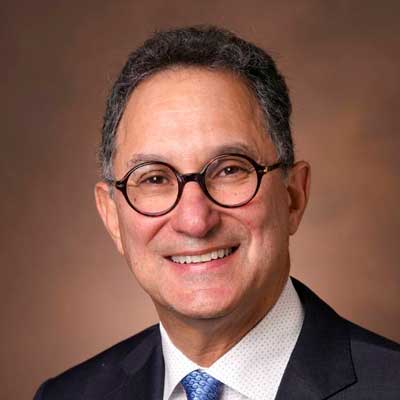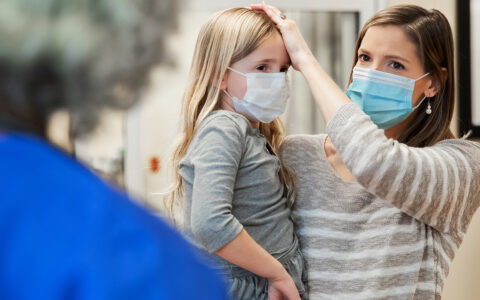On Tuesday, April 14, Vanderbilt University Medical Center hosted a virtual town hall to answer questions from community physicians and clinicians about patient care during the COVID-19 crisis. A panel of Vanderbilt experts discussed the current status of the pandemic in the Mid-South region, addressing current strategies for treatment, screening and new research into therapeutics.
The discussion below expands on questions from the town hall about the impact of the pandemic on Vanderbilt’s regional health system. Participants include Paul Sternberg, M.D., Chief Medical Officer at Vanderbilt University Medical Center, and Roger Dmochowski, M.D., Associate Surgeon in Chief.
Testing Strategies
Discoveries: What types of tests are currently available in our region?
Sternberg: At this time, the most commonly available test is a PCR test. Given our volume, we currently are able to get results in less than 12 hours. It is my understanding that when sent to commercial labs, they are reporting results in about three days. There also is a “rapid” test that is available at some places. This takes about 15 minutes, but only one test can be performed at a time, so even if run 24/7, you can only do about 100 tests per day.
Discoveries: When will antibody testing be widely available?
Sternberg: It is impossible to answer when it will be widely available. A lot will depend on developing a test that is adequately accurate – one of the challenges is being able to differentiate COVID-19 from other coronaviruses to avoid false positives. At Vanderbilt, we are testing some of the commercial tests being proposed as well as developing our own serology test.
Discoveries: What do you see as the most valuable testing strategy to combat the spread in our region in the coming months?
Sternberg: I think the most valuable strategy to combat the spread is social distancing, not a testing strategy. Most models for “flattening the curve” assume social distancing until the end of May. Since there are suggestions that a lot of affected people are asymptomatic, it would be valuable to learn if that is correct. This can only be done by either more widespread testing or by the development of a serology test that affirms past exposure. However, even if the serology test demonstrates the presence of antibodies to COVID-19, we don’t know the extent to which the presence of antibodies confers further immunity.
Discoveries: What tools are you finding most effective for communicating with patients and the larger public about test availability, policy changes, etc.?
Sternberg: For the public, our most valuable communication tool has been our COVID-19 website, which is updated daily. We have created hotlines for patients to phone in with questions; we also use our patient portal, My Health At Vanderbilt, as a source for communications. In addition, we publish an email newsletter – My VUMC – each day that shares new policies and programs with our workforce.
Referrals and Elective Criteria
Discoveries: Should patients still be referred for surgery?
Dmochowski: Absolutely. Currently, we have adequate resources to treat patients in need of our services. We believe our environment is safe and that coming into the hospital is not dangerous for our patients. We have partnered access with telehealth to allow distance evaluation and to expedite care.
Discoveries: What types of cases are still being done?
Sternberg: We have been performing a wide variety of urgent procedures, ranging from open-heart surgery to retinal detachment surgery and have not had any patients become infected.
Dmochowski: If postponing a surgery will cause the patient harm, we are proceeding with the surgery. For example, delaying cancer surgery risks tumor expansion and possibly metastasis, so we are continuing to perform these surgeries. There are many other conditions that can produce long-term disability or significant symptoms that impact the quality of life, which may be considered to be performed at this time.
Discoveries: With the current moratorium on elective procedures, how are you determining which cases should be postponed for now?
Sternberg: Up to this point, we largely leave it to the surgeon and patient to determine whether this is something that needs to be performed or can be delayed: if patients will suffer harm from waiting, then we are moving forward. Routine colonoscopy, cataract surgery, and plastic surgery are being postponed; cancer surgery will not be put off if delay risks tumor expansion and possible metastasis.
“If patients will suffer harm from waiting, then we are moving forward. Routine colonoscopy, cataract surgery, and plastic surgery are being postponed; cancer surgery will not be put off if delay risks tumor expansion and possible metastasis.”
Dmochowski: We are looking at these on a case-by-case basis and making the determination about whether it is best to proceed or wait – especially for cases that can be postponed but not for a long time. It’s really a multivariate equation, based on the dichotomy between urgent and emergent cases and the intent to preserve PPE. We will continually reappraise surgeries that have been delayed.
Discoveries: When do you anticipate that outpatient surgeries will be able to be performed?
Dmochowski: We will perform surgery as soon as it is safe, and we feel confident that adequate resources continue to be available. We will also coordinate these services with local and state governmental guidance.
Infection Prevention
Discoveries: What are you learning about how best to protect MDs and clinical staff?
Sternberg: Our team of Infection Prevention specialists has developed policies toward how best to protect physicians and staff. This has resulted in guidelines for standard patient interactions, as well as for patients that are COVID-19 positive and those that are PUIs (those under investigation awaiting test results). We also have created specific guidelines for the use of standard surgical masks, N95 masks, and PAPRs, based on what we know about the virus and the risk of different types of procedures and interactions. Additionally, we have a committee that meets daily to review requests to modify those PPE guidelines.
Dmochowski: We are also re-sterilizing some of our PPE, using UV and vaporized hydrogen peroxide technologies per the FDA-approved re-sterilization process.
Discoveries: What criteria do you use for these decisions in OR and non-OR procedural areas?
Dmochowski: Safety of our patients and providers is our primary objective. We know that in countries in which proper PPE is used, transmission rates are very low. Most of what we do is relatively safe. For procedures that generate aerosols, providers require higher levels of protection. We use the appropriate PPE for each procedure. The decision for what is appropriate PPE for specific procedures is made in consonance with our colleagues in Infection Prevention and Infectious Diseases with the evidence generated from CDC and FDA guidance documents.
Staffing and Telehealth
Discoveries: How has Vanderbilt addressed the need for more clinical staff, including possibly bringing in retired or non-clinical physicians?
Sternberg: Fortunately, the COVID-19 positive patient volume has not yet outstripped our physician workforce. However, we have developed a robust plan for redeployment of clinicians from across the medical center should there be a greater need for clinicians on the inpatient units than in the clinics. We also have updated and activated policies that allow for the addition of additional clinicians on an emergency basis, such as those who are retired, should that become necessary.
Discoveries: What are you learning so far about the effectiveness of telehealth? What is the level of satisfaction from the perspective of the clinician and the patient?
Dmochowski: Telehealth has been one of the few positive aspects of this tragedy. With new rules about using telehealth, we have been able to rapidly expand. People in multiple surgical subspecialties are using it with success. I have done it personally and think it is terrific.
“Telehealth has been one of the few positive aspects of this tragedy. With new rules about using telehealth, we have been able to rapidly expand. People in multiple surgical subspecialties are using it with success. I have done it personally and think it is terrific.”
Sternberg: Since we’ve had to postpone thousands of clinic visits, we have gone from fewer than 50 telehealth visits per day to around 2500! While both clinicians and patients are scaling a bit of a learning curve with this new technology, both groups have been elated with its value in maintaining touch with patients, while also helping manage chronic conditions – and triaging issues that may require intervention.
Discoveries: When we start to return to a post-COVID world, where do you think telehealth will fit into our patterns of care, including in surgical areas?
Sternberg: I think telehealth is, as they say in the old song, “here to stay.” In the weeks to come, we will learn more about which types of visits are most meaningful with this technology. As well, we hope that telehealth may allow us to optimize the use of our clinic space and our workforce, in that many visits that used to be crowded into the clinic will now be able to be conducted from our office or home.
Dmochowski: I am hoping we continue to expand it in the appropriate setting for the appropriate patients.
Impact on Health Systems
Discoveries: Are there any resource constraints that you anticipate in the near future that could impact surgery?
Dmochowski: We expect that COVID-19 cases will increase but not overwhelm our health care system. We believe that we will be fine in the near future.
Discoveries: What other changes resulting from this pandemic will continue to impact health systems? What about the surgery landscape in particular?
Sternberg: We are seeing that this pandemic is not going away soon – COVID-19 will be with us for a while. So, hospitals like ours are going to have to develop COVID-19 units and COVID-19 services, similar to what we saw happening during and following the AIDS crisis in the 90s. In addition, there will be changes to our universal precautions: remember that practitioners did not mask and glove for some groups of patients, as we do now, prior to HIV.
Dmochowski: I’m hoping we do more public health to prepare for the next one. I hope that we better recognize the needs of patients who have difficulty accessing our healthcare system.
Discoveries: Do you have an update on the impact, if any, that the coronavirus is having on the children’s hospital or the pediatric population?
Sternberg: Up to this point, there has not been a significant impact on our children’s hospital or pediatric population. While we are seeing children that are COVID-19 positive and have identified a unit for COVID-19 patients we have had only one admission, and none have required critical care or ventilator support. We will follow this closely.
Dmochowski: Children tend to handle the disease better than adults. Although there are deaths reported in children, the disease tends to be much milder.
Discoveries: What constructive lessons have been learned to date for our region’s health care system – where are the critical gaps?
Sternberg: We are fortunate that, unlike the New York City area, our region’s health care system has not been overwhelmed by cases. However, I think this has reminded us about two things: 1) that our rural communities have limited hospital resources, and 2) that we have limited resources for the more diverse members of our population. It’s difficult to translate through a mask.






